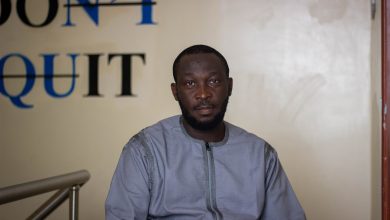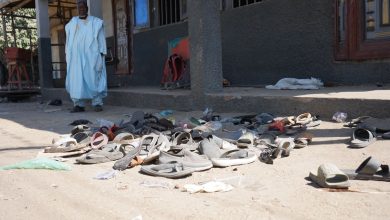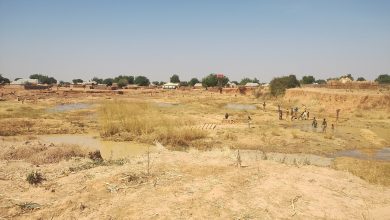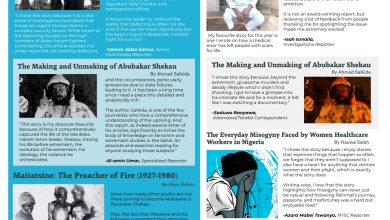Yola Residents Struggle To Rebuild After Floods
On July 27th, floods ravaged Shagari, Yolde Pate, and Sabon Pegi in Yola, Adamawa State, killing several people, destroying homes, and displacing residents to an under-resourced temporary shelter. Now, with the camp closed, they return to devastated homes.
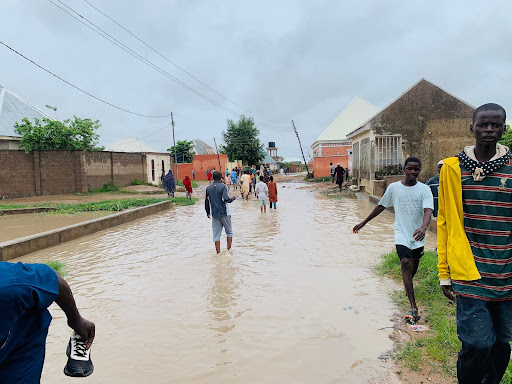
In the early hours of Sunday, July 27, as most of Yola South slept, a violent flood tore through the communities of Sabon Pegi, Yolde Pate, and Shagari, submerging homes and shaking lives in the darkness. Panic spread as terrified families scrambled to higher ground with parents clutching their children and whatever belongings they could salvage. While some residents found safety in the highlands, others were trapped in their homes because the water levels were too high.
One of the trapped residents was Hope Bitrus.
Hope, a resident of Sabon Pegi in Yola South, Adamawa State, northeastern Nigeria, said, like everyone in the community, the flood took her family by surprise, as it came while they were asleep around 3 a.m.
“We heard someone knocking on the door. It was our neighbour who came to inform us that the whole street was getting flooded,” she told HumAngle.
Just then, her whole verandah became flooded, and the water level rose so high that it poured into their rooms through the open window.
“And at that point, we knew the best thing to do was to get out. My husband and I were able to get our smaller children out of the house, but their eldest sister, who was in the other room, was trapped,” she said.
Hope and her husband struggled with the door, but it didn’t open.
“There was no way we could leave without our daughter, so we screamed from outside the door and told her to climb through the window, but then, the water was pouring inside her room through the window.”
The girl started to panic, crying, and her parents got even more confused.
“We added more pressure on the door and managed to open it, and then she was able to get out,” she recalled.
By the time the girl got out, the water level had gone higher. All three of them had to climb the wall for support and then get to the roof for safety.
“I watched my items flooding away. I think the things that didn’t move were the couch and other heavy items, but clothes, utensils, food items, and other things were washed away before our eyes,” Hope said.
No place like home
Like Hope Bitrus, many residents of the affected communities lost their properties and valuables in the flood. When HumAngle spoke to some of them on the day of the incident, their basic concern was food and shelter.
To address these immediate concerns, the Adamawa State government turned a public secondary school in Yola South into a temporary displacement camp. Security forces were deployed to guard the area and regulate movement among the displaced.
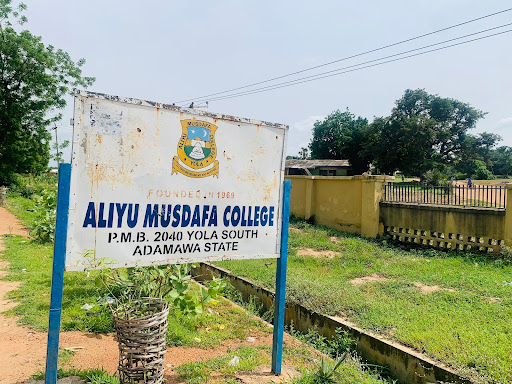
HumAngle learned that a public announcement was made, urging all those affected by the flood to come to the school for formal registration.
According to the National Emergency Management Agency (NEMA), a total of 5560 persons were displaced; about 927 households were affected, with 524 households displaced, and 25 people dead. At least 11 people are still missing.
“When the announcement was made, even those who were not affected by the flooding trooped into the school to obtain meal tickets and registration cards, so by the time most of us who were affected got there, basic relief items had finished,” Rukaiyah Hamid Jalo, one of the affected residents from Yola Bypass, told HumAngle.
Hope explained that during the three days they spent in the makeshift camp, she and her family had to spread a wrapper on the bare floor for the children to sleep because the camp had insufficient supplies like mats and blankets.
“Before we got the news that the camp was opened and that people were asked to come and register, it was already Monday, so by the time we reached, relief materials like mats, buckets, and soaps were already shared by the Red Cross, so we didn’t get any,” she said.
Like many others, Chafari Wisdom, another affected resident, told HumAngle that her family couldn’t access basic supplies in the camp due to severe shortages. She added that the classrooms were overcrowded and lacked mats to lie on, leaving her desperate to return home, even though her home was ruined.
“One morning, my sister and I left the camp to go and check our home because we wanted to leave there as soon as possible but when we got home, we noticed that even though the water level had gone down, the place was yet to dry up so we had no choice but to go back to the camp because there was no place we can stay,” Chafari said.
When HumAngle visited the temporary camp, the crowd was largely made up of women sitting in groups. Some of them explained that their husbands had stayed behind to guard what was left of their destroyed homes to prevent vandalism and theft.
Healthcare workers from the primary healthcare centres in Yola South, the International Community of the Red Cross (ICRC), Nigerian Air Force emergency clinic, and others were deployed to provide medical assistance to the people. Complicated cases were said to be referred to the State Specialist Hospital.
In the school kitchen, members of the ICRC had taken over to cook meals for the displaced.
Despite getting a roof over their heads, Hope said there was nowhere she wanted to be other than home because life in the camp was difficult.
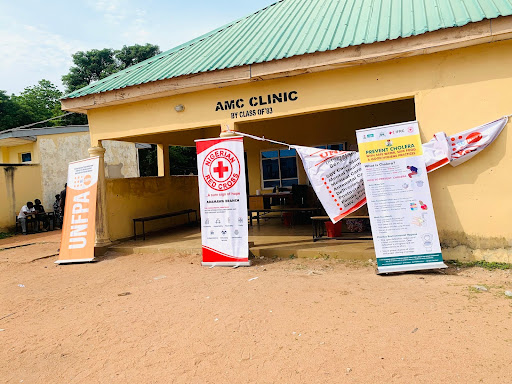
HumAngle gathered that the displaced people receive two meals a day provided by the ICRC. Civil society organisations and some individuals have also visited the camp to distribute cooked meals and snacks. However, some of the displaced people said the crowd was so much that the food hardly went round.
Chafari mentioned that she had to leave the camp one time and head back to her house to see if she could get something for her children when the food rations didn’t reach them.
“I couldn’t get anything. The entire storeroom was flooded,” she said.
A woman who pleaded anonymity told HumAngle that she felt abandoned by the government because most of the healthcare and feeding support they received in the camp was from non-profit organisations, particularly the Red Cross.
“We were overcrowded. We barely had any food. At one point, we just wanted to go back home even though it was yet to dry up,” she said.
HumAngle tried to reach the Adamawa State Emergency Management Agency (ADSEMA) for a comment on matters like the shortage of food and basic supplies, but all efforts proved abortive.
On July 30th, the Agency’s executive secretary, Celine Laori, disclosed during a gathering where HumAngle was present that the camp was officially closing based on directives from the Adamawa State Governor. Displaced persons received cash tokens, relief materials like blankets, mats, rice, and noodles.
Even though residents like Hope and Chafari wanted to get back home due to a lack of access to food and relief materials, others were not ready. HumAngle observed that some houses, particularly at the end of Shagari Phase 2, were yet to dry up, but since the camp has been closed barely 3 days into operation, residents were left with no choice
Back to the ruins
On the streets of Yola By-pass and Sabon Pegi, drenched carpets, mattresses, and furniture were littered across the streets to dry. Collapsed fences and broken walls showed dismantled roofs and ruined homes. Women and children swept and mopped while some men collected blocks and zincs.
Chafari’s entire furniture is covered in mud, with many items gone. She noted that apart from the financial cost of the incident, she is also grappling with the mental toll.
“Among the dead bodies recovered from the flood were my neighbour’s children. Two of them were washed away, and right now, their father is yet to be found. We don’t know whether he’s dead or alive,” she said.
Rukaiyah is back home with her children, but she says she doesn’t know where to begin. Even though the token she received at the camp doesn’t make up a fraction of what she had lost, she expressed gratitude for it.
Enoch Jared, a resident of Sabon Pegi, said he didn’t go to the camp because his family had already managed to wash one of the rooms after the floods and so they stayed there instead. He also needed to be at home to watch over what was left of his house since the floods destroyed the fence.
“It’s been days since the incident occurred, and no one from the government has come down to even greet or check up on us in our community. Only those who made it to the camp got aid,” he said.
After losing his animals, properties, and a portion of his home, Enoch said right now, he’s focused on fixing his fence and ensuring his family members get food on their table.
The cause
Since the flooding occurred, there has been intense debate among locals and on social media about its cause. Some alleged that a Chinese mining company operating in Bole, a community in Yola South, blocked a natural water channel due to its mining activities. As a result, when heavy rainfall occurred, the water had no passage and was forced to flow back into residential areas. Others claimed that a dam in the Bole area had broken, thus triggering the flood.
HumAngle visited the Bole community and the mining site, which is used for extracting fluoride. While the dam itself remains intact, HumAngle observed that a waterway was constructed by the mining company to reduce excess water from the dam when it reaches high levels. The diverted water from the dam flows through the company’s man-made water channel and then empties itself into the Yola River.
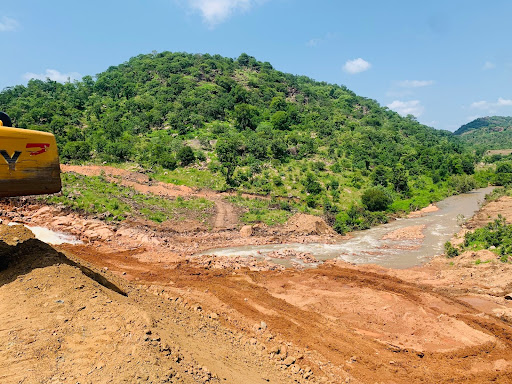
A stakeholder in the Bole community and also a staff member of the Mining Company, Aliyu Umaru, said allegations that the mining activities blocked a water channel or that a dam broke are untrue.
According to him, the company constructed the dam to serve as a water source for washing extracted materials during the mining exercise.
“We have a license here, and the government is aware, so it is our responsibility to protect the community and not do anything to harm it,” Aliyu said.
The Governor of Adamawa State, Ahmadu Umaru Fintiri, and his team visited the mining site in Bole on July 30th for an assessment. The visit was said to be prompted by concerns raised by locals who attribute the flooding to the mining incidents. After conducting the assessment, the Governor clarified that neither the dam nor the mining activities were responsible for the flood. He stated that the unauthorised construction of buildings on waterways and drainage channels impeded the natural flow of water, thus resulting in the flood.
A devastating flood struck the Yola South region of Adamawa State, northeastern Nigeria, submerging homes and displacing numerous families as they scrambled for safety. Many residents, including Hope Bitrus, described the chaos and struggle of escaping their submerged homes during the night. The Adamawa State government established a temporary camp at a local school for the displaced, yet residents faced shortages of basic supplies, food, and shelter, prompting dissatisfaction among those affected.
Over 5,500 people were displaced, with fatalities and missing persons reported, prompting interventions from the National Emergency Management Agency and various NGOs. The displaced received limited supplies and healthcare support, despite severe needs. The cause of the flood was debated, with some attributing it to mining activities in the nearby Bole community; however, the state governor clarified that unauthorized construction on waterways contributed to the disaster, urging caution against building in such areas.
Support Our Journalism
There are millions of ordinary people affected by conflict in Africa whose stories are missing in the mainstream media. HumAngle is determined to tell those challenging and under-reported stories, hoping that the people impacted by these conflicts will find the safety and security they deserve.
To ensure that we continue to provide public service coverage, we have a small favour to ask you. We want you to be part of our journalistic endeavour by contributing a token to us.
Your donation will further promote a robust, free, and independent media.
Donate HereStay Closer To The Stories That Matter

